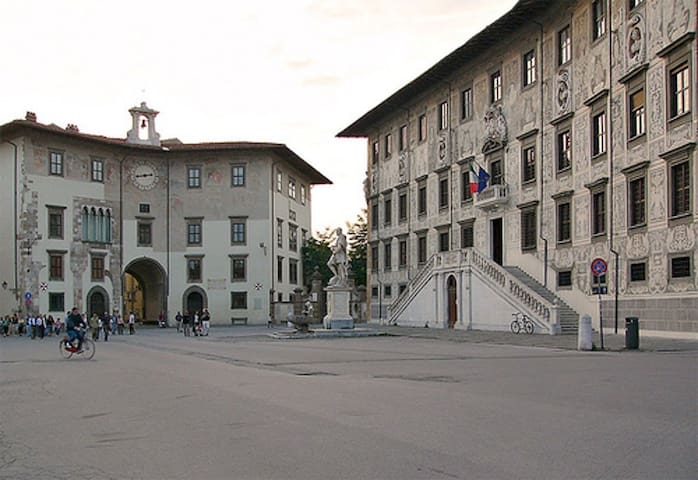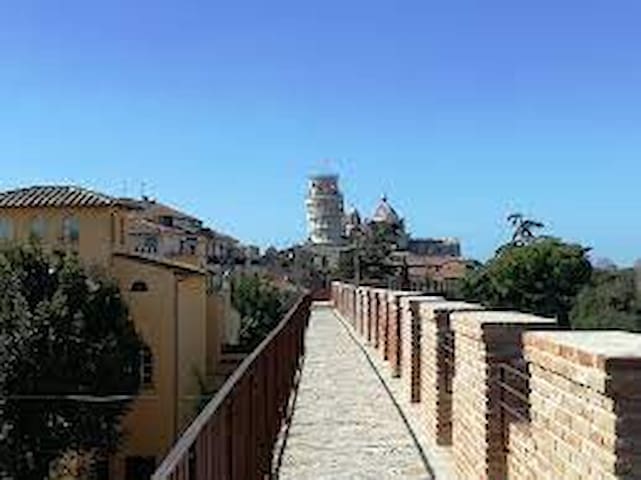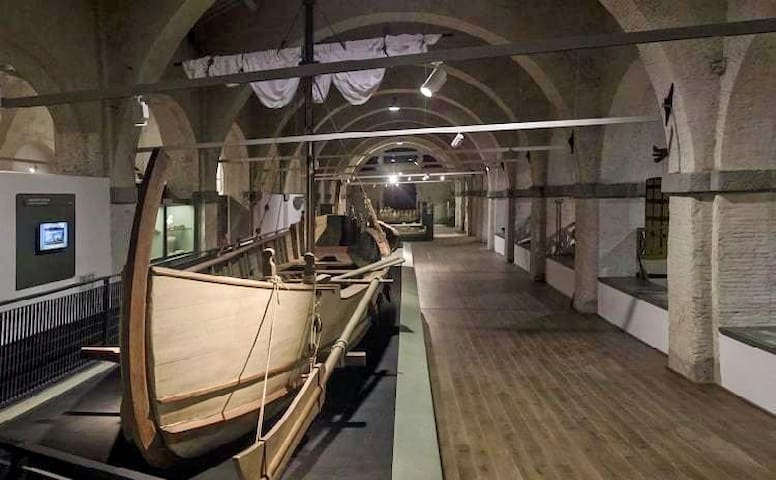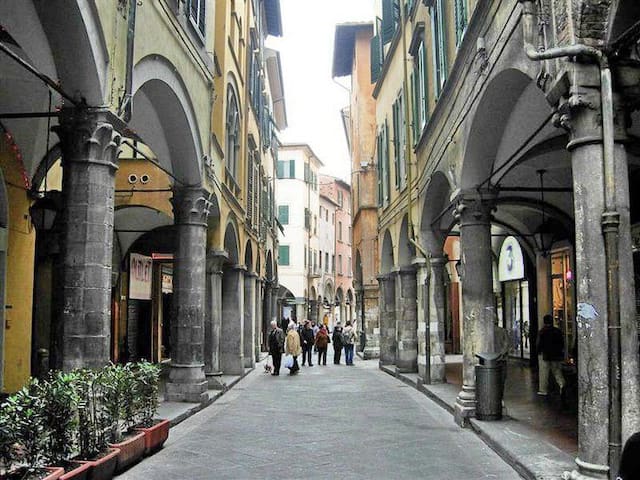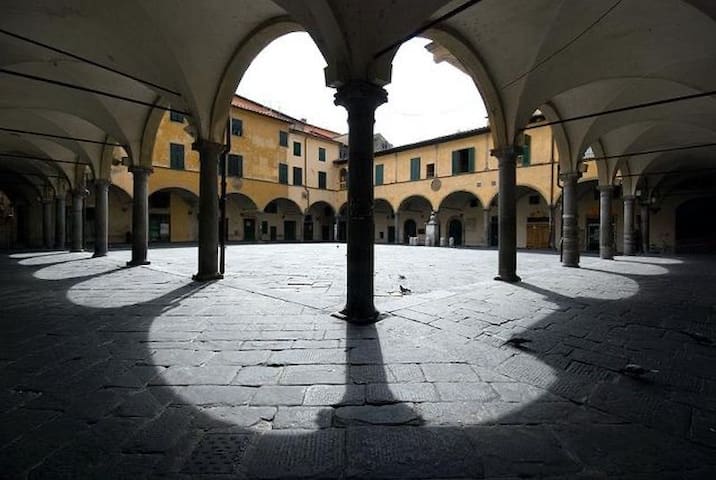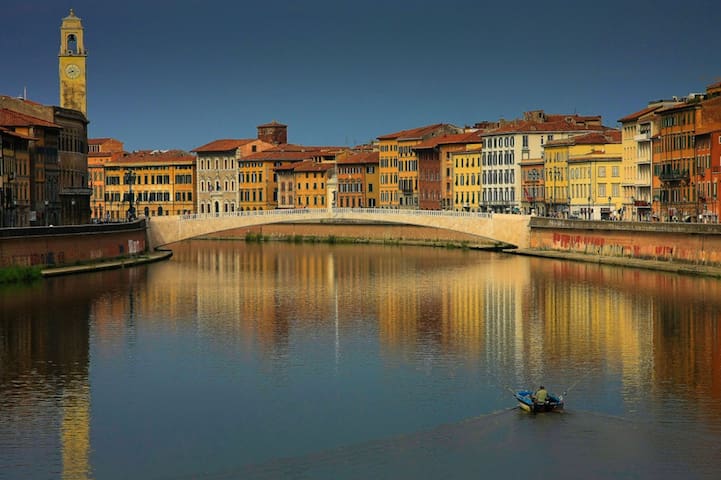Visite turistiche
The Knights’ Square is the second main square of the city. This square was the political centre in medieval Pisa. After the middle of the 16th century the square became the headquarters of the Order of the Knights of St. Stephen. Now it is a centre of education, being the main house of the Scuola Normale di Pisa, a higher learning institution part of the University.
6 personas del lugar lo recomiendan
Piazza dei Cavalieri
Piazza dei CavalieriThe Knights’ Square is the second main square of the city. This square was the political centre in medieval Pisa. After the middle of the 16th century the square became the headquarters of the Order of the Knights of St. Stephen. Now it is a centre of education, being the main house of the Scuola Normale di Pisa, a higher learning institution part of the University.
The walkway of the Pisa’s Walls, with its 11 meters high, gives to the public the possibility to observe the city from an original perspective. A pleasant walk to admire from above the typical Pisan overview, from Piazza dei Miracoli to Piazzetta Del Rosso.
An itinerary that surprises the visitor for the beauty of the places, among recovered garden, archaeological and artistic treasures.
The building of the Pisa’s Walls began in 1154 in the area of the city north of the Arno river; the construction lasted until 1161, followed by a further completion in 1284 in the area of Cittadella Vecchia.
19 personas del lugar lo recomiendan
Ancient Walls of Pisa
Piazza dei MiracoliThe walkway of the Pisa’s Walls, with its 11 meters high, gives to the public the possibility to observe the city from an original perspective. A pleasant walk to admire from above the typical Pisan overview, from Piazza dei Miracoli to Piazzetta Del Rosso.
An itinerary that surprises the visitor for the beauty of the places, among recovered garden, archaeological and artistic treasures.
The building of the Pisa’s Walls began in 1154 in the area of the city north of the Arno river; the construction lasted until 1161, followed by a further completion in 1284 in the area of Cittadella Vecchia.
Chagall, Dalí, Duchamp, Kandinsky, Miró, Picasso, Matisse, Mondrian, Klee are the protagonists of The Avant-Garde exhibition. Masterpieces from the Philadelphia Museum of Art at Palazzo Blu – from September 28, 2023 to April 7, 2024.
120 personas del lugar lo recomiendan
Palazzo Blu
9 Lungarno GambacortiChagall, Dalí, Duchamp, Kandinsky, Miró, Picasso, Matisse, Mondrian, Klee are the protagonists of The Avant-Garde exhibition. Masterpieces from the Philadelphia Museum of Art at Palazzo Blu – from September 28, 2023 to April 7, 2024.
The Botanical Garden in Pisa, founded in 1543-1544 on the banks of the Arno by the naturalist Luca Ghini, is the first university botanical garden in the world. In 1591, it was moved to its current location in the heart of the historic center, between piazza dei Miracoli and piazza dei Cavalieri. The botanical garden extends across three hectares and is home to plants from all over the world, including medicinal plants like foxgloves, aquatic plants, and centuries-old trees, such as a majestic magnolia and a ginkgo planted at the end of the 1700s and an enormous camphor tree planted in 1872.
47 personas del lugar lo recomiendan
Jardín Botánico y Museo de Pisa
13 Via Luca GhiniThe Botanical Garden in Pisa, founded in 1543-1544 on the banks of the Arno by the naturalist Luca Ghini, is the first university botanical garden in the world. In 1591, it was moved to its current location in the heart of the historic center, between piazza dei Miracoli and piazza dei Cavalieri. The botanical garden extends across three hectares and is home to plants from all over the world, including medicinal plants like foxgloves, aquatic plants, and centuries-old trees, such as a majestic magnolia and a ginkgo planted at the end of the 1700s and an enormous camphor tree planted in 1872.
The exhibition of “Le Navi Antiche di Pisa” takes place in the majestic rooms and aisles of the “Arsenali Medicei” (the Medicean Arsenals), along the Arno river.
They were built almost 400 years ago by Grand Duke Cosimo I de’ Medici’s will. He wanted to strengthen his naval power and resuscitate the ancient glories of Pisa Maritime Republic.
The majestic rooms and the aisles, originally built to accommodate great Grand Duke ships, are now the perfect place to display the wonderful restored ships. Here the grandiose Roman ships are exhibited, as a starting point for the long history of sailing in Pisa, now finding new life inside the rooms of the museum.
In 1998, in Pisa outskirts towards the sea, the Italian Railways started the construction works to build a control center for the Rome-Genoa line, next to Pisa San Rossore station. Immediately some wooden objects began to be unearthed and the archaeologists realized the immense value of this discovery.
In particular, what emerged 6 meters underground was an incredible series of ship wreckages, including their loads of commercial items and various remnants of life on board, in an extraordinary state of preservation.
The excavation site of Ancient Roman ships of Pisa, originated from this discovery, was completed in 2016 and it brought to light about thirty Roman boats and thousands of fragments of pottery, glass, metal and traces of organic materials. This is one of the most interesting and rich excavation and research sites of the last few years.
30 personas del lugar lo recomiendan
Museo de Barcos Antiguos de Pisa
16 Lungarno Ranieri SimonelliThe exhibition of “Le Navi Antiche di Pisa” takes place in the majestic rooms and aisles of the “Arsenali Medicei” (the Medicean Arsenals), along the Arno river.
They were built almost 400 years ago by Grand Duke Cosimo I de’ Medici’s will. He wanted to strengthen his naval power and resuscitate the ancient glories of Pisa Maritime Republic.
The majestic rooms and the aisles, originally built to accommodate great Grand Duke ships, are now the perfect place to display the wonderful restored ships. Here the grandiose Roman ships are exhibited, as a starting point for the long history of sailing in Pisa, now finding new life inside the rooms of the museum.
In 1998, in Pisa outskirts towards the sea, the Italian Railways started the construction works to build a control center for the Rome-Genoa line, next to Pisa San Rossore station. Immediately some wooden objects began to be unearthed and the archaeologists realized the immense value of this discovery.
In particular, what emerged 6 meters underground was an incredible series of ship wreckages, including their loads of commercial items and various remnants of life on board, in an extraordinary state of preservation.
The excavation site of Ancient Roman ships of Pisa, originated from this discovery, was completed in 2016 and it brought to light about thirty Roman boats and thousands of fragments of pottery, glass, metal and traces of organic materials. This is one of the most interesting and rich excavation and research sites of the last few years.
Borgo Stretto, the most expensive and elite shopping street in the city.
This exclusive pedestrian zone also houses Galileo Galilei’s birthplace.
Visitors can have a wonderful time at trendy bars, expensive boutiques, popular pastry shops and more.
59 personas del lugar lo recomiendan
Borgo Stretto
Borgo Stretto, the most expensive and elite shopping street in the city.
This exclusive pedestrian zone also houses Galileo Galilei’s birthplace.
Visitors can have a wonderful time at trendy bars, expensive boutiques, popular pastry shops and more.
In medieval times it was known as Piazza de’ Porci. The name perhaps derives from the presence of a (meat?) market, also testified by a well now partially visible in the southwest corner. The square is an irregular quadrilateral, with a double arched loggia, supported by sandstone columns. From the eighteenth century, the square took the name of Vettovaglie, from the sale of various foods, and it was equipped with a fountain. The marble panel with the units of measurement for the sale of products is still visible under the southern loggia. Today, the square is the centre of the university's nightlife.
Piazza delle Vettovaglie, 56126 Pisa PI, Italia
In medieval times it was known as Piazza de’ Porci. The name perhaps derives from the presence of a (meat?) market, also testified by a well now partially visible in the southwest corner. The square is an irregular quadrilateral, with a double arched loggia, supported by sandstone columns. From the eighteenth century, the square took the name of Vettovaglie, from the sale of various foods, and it was equipped with a fountain. The marble panel with the units of measurement for the sale of products is still visible under the southern loggia. Today, the square is the centre of the university's nightlife.
Many poets and artists have been fascinated by Lungarni Pisani having inspiration from the beautiful noble palaces that overlook the Arno river. Today, this location also features important museums along the Arno river creating a real "museum system." This is a picturesque walk which has as its theme the river has always been inextricably linked to the life of the city.
13 personas del lugar lo recomiendan
Lungarni di Pisa
Ponte SolferinoMany poets and artists have been fascinated by Lungarni Pisani having inspiration from the beautiful noble palaces that overlook the Arno river. Today, this location also features important museums along the Arno river creating a real "museum system." This is a picturesque walk which has as its theme the river has always been inextricably linked to the life of the city.
This palazzo, which looks onto the Lungarno Galilei, bears the name of one of Pisa's most illustrious families, lead players in aristocratic circles and in every branch of civic and political life. It was a member of the latter, canon Alessandro Lanfranchi, who purchased the bankside building in 1539.
Today this historical building in Pisa houses the Museum of Graphics and Drawing, which boasts one of the most important public collections of contemporary graphics. Thanks to the permanent collections and the offer of temporary exhibitions, the Museum is an important center for the study of contemporary art.
Palazzo Lanfranchi
This palazzo, which looks onto the Lungarno Galilei, bears the name of one of Pisa's most illustrious families, lead players in aristocratic circles and in every branch of civic and political life. It was a member of the latter, canon Alessandro Lanfranchi, who purchased the bankside building in 1539.
Today this historical building in Pisa houses the Museum of Graphics and Drawing, which boasts one of the most important public collections of contemporary graphics. Thanks to the permanent collections and the offer of temporary exhibitions, the Museum is an important center for the study of contemporary art.
The Church, founded in 1230 was once named S. Maria del Ponte novo (St. Mary’s by the New Bridge) and was a votive oratory. It used to be situated at the foot of the bridge that connected via St. Antonio to via S. Maria.
Because of subsidence, the church often had to be repaired and eventually, in the mid 19th century, it was decided to dismantle and move it to a position higher above the river bed where it was built.
55 personas del lugar lo recomiendan
Iglesia de Santa Maria della Spina
Lungarno GambacortiThe Church, founded in 1230 was once named S. Maria del Ponte novo (St. Mary’s by the New Bridge) and was a votive oratory. It used to be situated at the foot of the bridge that connected via St. Antonio to via S. Maria.
Because of subsidence, the church often had to be repaired and eventually, in the mid 19th century, it was decided to dismantle and move it to a position higher above the river bed where it was built.
The museum is housed in the rooms of the old Benedictine convent of S. Matteo in Soarta (11th century) very little of which remains after alterations and restoration after the last war, apart from the church and a few pieces of medieval wall.
The museum contains the largest collection of works of art in Pisa: a remarkable store of medieval pottery, several precious jewels and a selection of medieval coins and seals from the Franceschi and Supino collections. There are stone statues dating from the middle ages to the 16th century, in particular, fine examples of Romanesque sculpture and masterpieces by Nicola Pisano e Donatello. There is also a collection of wooden sculptures and relevant paintings with over two hundred works ranging from the very early 1200s to the modern age.
82 personas del lugar lo recomiendan
National Museum of San Matteo, Pisa
1 Piazza San Matteo In SoartaThe museum is housed in the rooms of the old Benedictine convent of S. Matteo in Soarta (11th century) very little of which remains after alterations and restoration after the last war, apart from the church and a few pieces of medieval wall.
The museum contains the largest collection of works of art in Pisa: a remarkable store of medieval pottery, several precious jewels and a selection of medieval coins and seals from the Franceschi and Supino collections. There are stone statues dating from the middle ages to the 16th century, in particular, fine examples of Romanesque sculpture and masterpieces by Nicola Pisano e Donatello. There is also a collection of wooden sculptures and relevant paintings with over two hundred works ranging from the very early 1200s to the modern age.
An art collection unlike any other in the world.
The Sinopie Museum in Pisa is located in Piazza dei Miracoli, in the ex-Spedale della Misericordia.
The Museum is dedicated to sinopie, or fresco preparatory drawings, which are quite useful for art historians because they help scholars distinguish between the various artists who collaborated on a work of art.
In the Museum, visitors can admire preparatory drawings by numerous artists from the 14th and 15th centuries that worked for years decorating the walls of the Camposanto.
25 personas del lugar lo recomiendan
Sinopie Museum
Piazza del DuomoAn art collection unlike any other in the world.
The Sinopie Museum in Pisa is located in Piazza dei Miracoli, in the ex-Spedale della Misericordia.
The Museum is dedicated to sinopie, or fresco preparatory drawings, which are quite useful for art historians because they help scholars distinguish between the various artists who collaborated on a work of art.
In the Museum, visitors can admire preparatory drawings by numerous artists from the 14th and 15th centuries that worked for years decorating the walls of the Camposanto.

